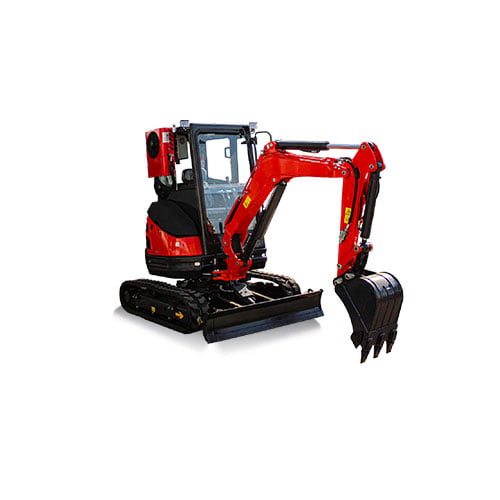Introduction

In the realm of urban construction and development, the choice of equipment plays a crucial role in determining project efficiency, cost-effectiveness, and environmental impact. Compact 2.5t excavators have emerged as indispensable tools in urban settings due to their versatility, maneuverability, and ability to operate effectively in confined spaces. This blog delves into the specific advantages of utilizing these excavators in urban environments, exploring their applications, benefits, technical specifications, and real-world examples.
Applications of 2.5t Excavators
Compact 2.5t excavators are adept at performing a wide range of tasks essential to urban development:
- Utility Trenching: Excavators are used extensively for digging trenches to lay down utility lines such as water pipes, electrical cables, and sewage systems. Their compact size allows them to access tight spaces between existing infrastructure without disrupting urban traffic.
- Foundation Digging: When constructing new buildings or renovating existing structures in urban areas, excavators are instrumental in digging foundations swiftly and efficiently.
- Demolition in Confined Spaces: Urban redevelopment often requires demolition of old structures in tight quarters. 2.5t excavators can dismantle buildings with precision, minimizing collateral damage and ensuring safety in densely populated areas.
- Landscaping and Maintenance: These excavators are utilized for landscaping tasks such as digging ponds, leveling ground, and planting trees in urban parks and gardens. Their precise control allows operators to maintain green spaces with minimal disturbance.
- Road Repairs: Urban roads frequently require maintenance and repair. Excavators facilitate tasks such as pothole repair, asphalt removal, and roadbed preparation, enabling quick and efficient restoration of urban infrastructure.
Advantages in Urban Settings
The compact size of 2.5t excavators is perhaps their most significant advantage in urban environments. Unlike larger equipment, they can navigate through narrow streets, alleys, and congested areas without causing disruptions to traffic flow or pedestrians. Their maneuverability allows them to access construction sites located within enclosed spaces or between existing buildings, where larger machinery would struggle to operate effectively. This flexibility translates into increased productivity and reduced project timelines, as operators can complete tasks swiftly without the logistical challenges posed by larger equipment.
Moreover, 2.5t excavators contribute to a quieter and less disruptive urban environment due to their reduced noise emissions compared to larger construction machinery. This makes them suitable for daytime construction projects in residential neighborhoods or commercial areas where noise restrictions may apply. Additionally, their lower fuel consumption and efficient engine design contribute to reduced environmental impact, aligning with sustainability goals increasingly prioritized in urban planning and development.
Case Studies and Examples
Real-world examples illustrate the effectiveness of 2.5t excavators in urban projects. For instance, in the redevelopment of a city center, these excavators were pivotal in excavating foundation pits for new high-rise buildings without obstructing adjacent pedestrian pathways or existing underground utilities. Similarly, in urban parks renovation projects, they were used to create artificial ponds and clear debris, enhancing the aesthetic appeal and functionality of public spaces while adhering to strict environmental regulations.
Benefits for Contractors and Operators
Contractors and operators benefit significantly from choosing 2.5t excavators for urban projects:
- Lower Operational Costs: Compact excavators typically consume less fuel and require fewer maintenance interventions compared to larger machinery, resulting in lower operating expenses over the project lifecycle.
- Increased Productivity: The agility and versatility of these excavators enable operators to complete more tasks per day, enhancing overall project efficiency and profitability.
- Enhanced Safety: Maneuvering through crowded urban environments poses unique safety challenges. Compact excavators equipped with advanced safety features such as rear-view cameras and proximity sensors help mitigate risks associated with operating in densely populated areas, ensuring the safety of both operators and bystanders.
Technical Specifications and Features

Key technical specifications that make 2.5t excavators well-suited for urban use include:
- Engine Power and Performance: Despite their compact size, modern excavators in this category boast powerful engines capable of handling demanding urban construction tasks.
- Hydraulic System Capabilities: Efficient hydraulic systems enable precise control of attachments, enhancing operational versatility and productivity.
- Control Features: Ergonomically designed operator controls and advanced monitoring systems ensure ease of operation and facilitate optimal performance in urban environments.
Conclusion
Compact 2.5t excavators represent a cornerstone in modern urban construction and development, offering unparalleled versatility, efficiency, and environmental responsibility. Their ability to navigate tight urban spaces while performing a diverse range of tasks makes them indispensable tools for contractors and operators aiming to optimize project outcomes in urban environments. As cities continue to grow and evolve, the role of these excavators in shaping sustainable and resilient urban landscapes is poised to expand, driving innovation and efficiency in urban construction practices.
FAQ
Q:What is a 2.5t excavator?
A:A 2.5t excavator is a compact machine weighing approximately 2.5 tons, designed for maneuverability and versatility in urban construction projects.
Q:What are the key advantages?
A:Key advantages include maneuverability in tight spaces, versatility for various tasks like trenching and demolition, and reduced environmental impact compared to larger machinery.
Q:What are the typical applications of a 2.5t excavator in urban construction?
A:Typical applications include utility trenching, foundation digging, demolition in confined spaces, landscaping, and road maintenance tasks such as pothole repair and sidewalk installation.
Q:How do 2.5t excavators contribute to efficiency in urban projects?
A:Their compact size allows them to access confined areas easily, reducing the need for manual labor and minimizing disruption to surrounding infrastructure and traffic flow.
Q:What should contractors consider before choosing a 2.5t excavator?
A:Factors to consider include the machine’s dimensions relative to site access points, compatibility with necessary attachments, operational costs such as fuel efficiency, and adherence to noise and emissions regulations in urban areas.
Are 2.5t excavators suitable for urban projects with stringent noise regulations?
Yes, 2.5t excavators typically have quieter operation compared to larger machinery, making them suitable for urban projects where noise levels must be minimized to comply with local regulations and reduce disturbance to residents and businesses.




